Tumor cell marker PVRL4 (nectin 4) is an epithelial cell receptor for measles virus
- PMID: 21901103
- PMCID: PMC3161989
- DOI: 10.1371/journal.ppat.1002240
Tumor cell marker PVRL4 (nectin 4) is an epithelial cell receptor for measles virus
Abstract
Vaccine and laboratory adapted strains of measles virus can use CD46 as a receptor to infect many human cell lines. However, wild type isolates of measles virus cannot use CD46, and they infect activated lymphocytes, dendritic cells, and macrophages via the receptor CD150/SLAM. Wild type virus can also infect epithelial cells of the respiratory tract through an unidentified receptor. We demonstrate that wild type measles virus infects primary airway epithelial cells grown in fetal calf serum and many adenocarcinoma cell lines of the lung, breast, and colon. Transfection of non-infectable adenocarcinoma cell lines with an expression vector encoding CD150/SLAM rendered them susceptible to measles virus, indicating that they were virus replication competent, but lacked a receptor for virus attachment and entry. Microarray analysis of susceptible versus non-susceptible cell lines was performed, and comparison of membrane protein gene transcripts produced a list of 11 candidate receptors. Of these, only the human tumor cell marker PVRL4 (Nectin 4) rendered cells amenable to measles virus infections. Flow cytometry confirmed that PVRL4 is highly expressed on the surfaces of susceptible lung, breast, and colon adenocarcinoma cell lines. Measles virus preferentially infected adenocarcinoma cell lines from the apical surface, although basolateral infection was observed with reduced kinetics. Confocal immune fluorescence microscopy and surface biotinylation experiments revealed that PVRL4 was expressed on both the apical and basolateral surfaces of these cell lines. Antibodies and siRNA directed against PVRL4 were able to block measles virus infections in MCF7 and NCI-H358 cancer cells. A virus binding assay indicated that PVRL4 was a bona fide receptor that supported virus attachment to the host cell. Several strains of measles virus were also shown to use PVRL4 as a receptor. Measles virus infection reduced PVRL4 surface expression in MCF7 cells, a property that is characteristic of receptor-associated viral infections.
Conflict of interest statement
The authors have declared that no competing interests exist.
Figures
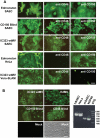
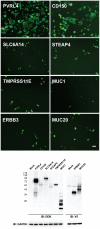
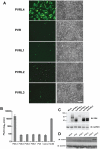
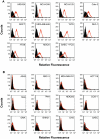
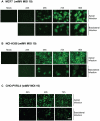

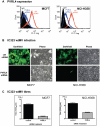
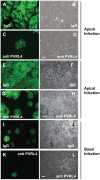
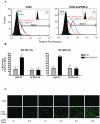
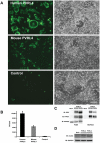
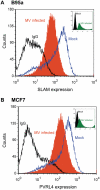
References
Publication types
MeSH terms
Substances
Grants and funding
LinkOut - more resources
Full Text Sources
Other Literature Sources
Molecular Biology Databases

